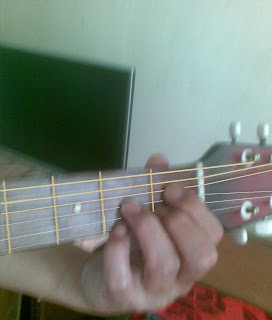Strumming Pattern No 4 (3/4 time signature strumming)
In this time signature the complete counting is: "1 and 2 and 3 and" or you can just simply do continuously count 1,2,3, 1,2,3, 1,2,3 and so on where "and" still work as an imaginary pace between the numbers in your counting.
The most basic 3/4 time strumming is this:
In music notation this measure compose only of three quarter notes in a bar. These means you will do a three downstroke strummings beginning with a single-string-downstroke on the root bass note of the chord followed by 2 downstrokes on the first four strings (string nos.1,2,3,4) all together. During the play as you count 1,2,3, the numbers here corresponds to your hand movements like these:
At count no.1 - you will strike only one string which is the root bass note of the chord in a single downstroke
At count nos.2,3 - you will strike only the first four strings (string nos 1,2,3,4) all together in 2 downstrokes
Play this strumming sequence in continuous succession to let your strumming hand be familiarized. This pattern is used in waltzes and other songs such as "Let Me Call You Sweetheart", "No Walls, No Ceilings, No Floors", "If I Ain't Got You" by Alicia Keys.
Root Bass Notes
Studies about bass notes and root notes may tackle a wider discussion. We can discuss that later. But for a more related and focused study, as we are dealing about strumming, its more practical to directly point to you where în every chord is that root bass note so that you can continue practicing the strumming now.
By the way remember that guitar strings are numbered from the thinnest string as the 1st string up to the thickest string as the 6th string. There are 3 treble strings (string nos 1,2,3) and 3 bass strings ( string nos 4,5,6). Also when we say "open chords" means those easy to execute chord positions where every finger is just pressing one string at a time. "Barre or bar chords" means the chord where your 1st finger (forefinger) lay flattened on the fretboard and pressing 2 or more strings in a chord just like in the F major and Bb major chords. On the list below, I just show the name of the chord family because its the same root bass note that you will play whether that chord is in any other form say for example Cmajor, Cminor, Cmaj7, Csus4, C7 and so on.
Shown here are two most usable chord positions, the open chord and the barre chord positions but some chords have no open position as indicated.
Root Bass Notes:
Chord Family Open Chord Position Barre Chord Position
1. C 5th string 5th string (3rd fret)
2. C# or Db none 5th string (4th fret)
3. D 4th string 5th string (5th fret)
4. Eb or D# none 5th string (6th fret)
5. E 6th string 5th string (7th fret)
6. F none 6th string (1st fret) 5th string (8th fret)
7. F# or Gb none 6th string (8th fret)
8. G 6th string 6th string (3rd fret)
9. G# or Ab none 6th string (4th fret)
10. A 5th string 6th string (5th fret)
11. Bb or A# none 5th string, (1st fret) and 6th string (6th fret)
12. B none 5th string (2nd fret) and 6th string (7th fret)
next will be another beautiful and more trendy 3/4 variation strumming, alternate bass playing, and the rest of the most widely used types of sterumming patterns..















 In this style you will learn how to play the likes of some good country or folk music like "A Horse With No Name by America, "Sugar Mountain" by Neil Young, "Crazy Little Thing Called Love" by Elvis Presley and many more. When you happened to hear the original version of the music, some instrumentation or some movements may be added to the music so just stick to our strumming pattern in order not to be disoriented. The encircled portion are only shown in order for you to map it clearly where you've been through, to allow you to see the difference between strumming patterns and to acquaint your hand to strumming changes.
In this style you will learn how to play the likes of some good country or folk music like "A Horse With No Name by America, "Sugar Mountain" by Neil Young, "Crazy Little Thing Called Love" by Elvis Presley and many more. When you happened to hear the original version of the music, some instrumentation or some movements may be added to the music so just stick to our strumming pattern in order not to be disoriented. The encircled portion are only shown in order for you to map it clearly where you've been through, to allow you to see the difference between strumming patterns and to acquaint your hand to strumming changes.